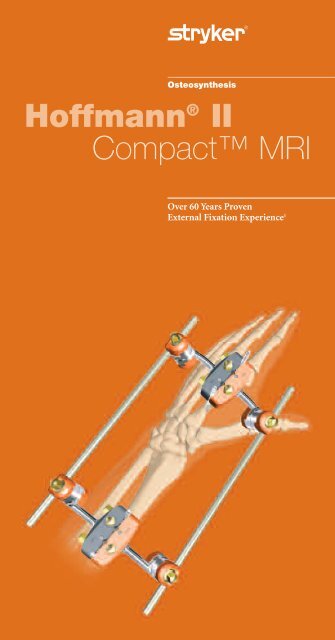Hoffmann® II Compact™ MRI - Stryker
Hoffmann® II Compact™ MRI - Stryker
Hoffmann® II Compact™ MRI - Stryker
You also want an ePaper? Increase the reach of your titles
YUMPU automatically turns print PDFs into web optimized ePapers that Google loves.
Hoffmann ® <strong>II</strong><br />
Compact <strong>MRI</strong><br />
Over 60 Years Proven<br />
External Fixation Experience 1
Hoffmann ® <strong>II</strong><br />
Compact <strong>MRI</strong><br />
<strong>Stryker</strong> continues its long history of innovation in<br />
external fixation by introducing a completely new<br />
system specifically designed for use in the <strong>MRI</strong><br />
environment:<br />
<strong>Hoffmann®</strong> <strong>II</strong> Compact <strong>MRI</strong> External<br />
Fixation System has been designed in<br />
compliance with ASTM Designation F2503-05 and<br />
is intended for use in <strong>MRI</strong> environments up to 3.0<br />
Tesla. The entire system was designed from the<br />
ground up for use in the <strong>MRI</strong> environment. The<br />
unique systemic approach of this design focuses in<br />
on the two key areas of concern in <strong>MRI</strong> use: frame<br />
displacement due to magnetic (mechanical) forces,<br />
and frame heating due to induced electrical currents<br />
(thermal forces):<br />
Addressing the<br />
Mechanical issues<br />
Non-ferromagnetic<br />
materials are used to<br />
construct all the<br />
metallic components:<br />
• Clamps and couplings<br />
are made from a<br />
combination of<br />
aluminum and<br />
austenitic steel 2<br />
• Posts and Apex® Half<br />
Pins are made from<br />
austenitic stainless<br />
steel<br />
Since these components<br />
are non-magnetic, the<br />
magnetic fields in the<br />
<strong>MRI</strong> environment will<br />
not cause the frame<br />
displacement that can<br />
pose a risk to the patient<br />
or scanner
Addressing the<br />
Thermal issue:<br />
Temperature increase of standard box frames in<br />
the <strong>Hoffmann®</strong> <strong>II</strong> <strong>MRI</strong> System<br />
Carbon Fiber rods are<br />
coated with Vectran:<br />
• Electrically insulating<br />
• Radiolucent<br />
• Light weight<br />
• Yellow color with easy<br />
to read size etchings<br />
Whole frame testing<br />
indicates these rods<br />
insulate against the<br />
induced electrical<br />
currents in the <strong>MRI</strong> and<br />
significantly reduce<br />
half pin heating. 3<br />
Of course the outstanding performance of the<br />
original <strong>Hoffmann®</strong> <strong>II</strong> Compact has been retained<br />
in the <strong>Hoffmann®</strong> <strong>II</strong> Compact <strong>MRI</strong><br />
External Fixation System:<br />
• Patented Snap-fit connections allow rapid frame<br />
construction. Also, additional clamps may be<br />
added at any time.<br />
• Single point of tightening for rapid and easy frame<br />
construction.<br />
• Independent, multiplanar pin placement allows<br />
flexibility in pin placement and very stable frame<br />
construction.<br />
• Small, lightweight clamps for lower profile frames,<br />
better visualization and access to the fracture site, as<br />
well as increased patient comfort.<br />
• Color coded components for easy identification.<br />
• Full System Compatibility for quick bridging to<br />
the larger <strong>Hoffmann®</strong> <strong>II</strong> <strong>MRI</strong> system.<br />
1<br />
The first Hoffmann frame was introduced by Dr. Raoul Hoffmann in1938. Asche, Roth, Schroeder.<br />
The External Fixator; Standard indications, operating instructions and examples of frame configurations.<br />
Einhorn-Presse Verlag 2002<br />
2<br />
Austenitic stainless steels are non-magnetic, non heat-treatable steels that are usually annealed and<br />
cold worked<br />
3<br />
John Nyenhuis, PhD; Professor of Electrical and Computer Engineering, Purdue University. Magnetic<br />
Resonance Imaging Testing of External Fixation Frames: <strong>Stryker</strong>® <strong>Hoffmann®</strong> <strong>II</strong> <strong>MRI</strong> vs. Synthes® <strong>MRI</strong><br />
Safe. <strong>Stryker</strong> White Paper 2005 Lit Number LSA55
ormities<br />
Trauma, Extremities & Deformities<br />
Biologics<br />
Surgical Products<br />
Neuro & ENT<br />
The information presented in this brochure is intended to demonstrate a <strong>Stryker</strong> product. Always<br />
refer to the package insert, product label and/or user instructions before using any <strong>Stryker</strong> product.<br />
Surgeons must always rely on their own clinical judgment when deciding which products and<br />
techniques to use with their patients. Products may not be available in all markets. Product availability<br />
is subject to the regulatory or medical practices that govern individual markets. Please contact your<br />
<strong>Stryker</strong> representative if you have questions about the availability of <strong>Stryker</strong> products in your area.<br />
<strong>Stryker</strong> Corporation or its subsidiary owns the registered trademark: <strong>Stryker</strong><br />
<strong>Stryker</strong> Corporation or its subsidiary owns, uses or has applied for the following trademarks:<br />
Hoffmann <strong>II</strong> Compact<br />
Literature Number: 5075-1-607<br />
LOT A0606<br />
Copyright © 2006 <strong>Stryker</strong><br />
Printed in Switzerland<br />
<strong>Stryker</strong> Trauma AG<br />
Bohnackerweg 1<br />
CH-2545 Selzach -Switzerland<br />
www.osteosynthesis.stryker.com

















